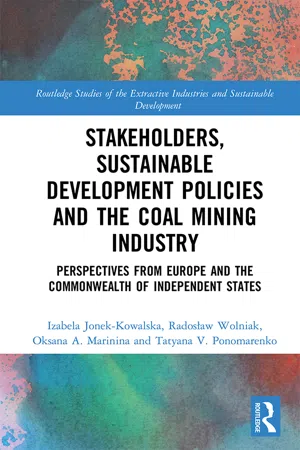
Stakeholders, Sustainable Development Policies and the Coal Mining Industry
Perspectives from Europe and the Commonwealth of Independent States
- 246 pages
- English
- ePUB (mobile friendly)
- Available on iOS & Android
Stakeholders, Sustainable Development Policies and the Coal Mining Industry
Perspectives from Europe and the Commonwealth of Independent States
About this book
This book identifies the impact of internal and external stakeholders on the implementation of sustainable development policies in the coal mining sector in Europe and the Commonwealth of Independent States.
The book assesses what activities and conditions need to be improved so that sustainable development policies can be more effectively and efficiently implemented. With a specific focus on the hard coal and lignite mining sectors, it examines a broad range of case studies from Eastern European countries and the Commonwealth of Independent States, including Russia, Ukraine, Poland, Kazakhstan, Germany, Spain, France and the United Kingdom, among many more. Beginning with an introduction to sustainable development and stakeholder theory, Part II then examines internal stakeholders, including owners, managers, employees and trade unions. Part III examines external stakeholders, touching upon those directly related to the mining industry, such as customers and mining enterprises, and those not directly associated such as local and regional communities and environmental organisations. The book concludes by proposing a model approach to the management of stakeholders involved in mining enterprises, focusing on improving the process of implementing sustainable development in the mining sector and strengthening the effects of this process.
This book will be of great interest to students and scholars of the extractive industries, natural resource management and policy and sustainable development.
Frequently asked questions
- Essential is ideal for learners and professionals who enjoy exploring a wide range of subjects. Access the Essential Library with 800,000+ trusted titles and best-sellers across business, personal growth, and the humanities. Includes unlimited reading time and Standard Read Aloud voice.
- Complete: Perfect for advanced learners and researchers needing full, unrestricted access. Unlock 1.4M+ books across hundreds of subjects, including academic and specialized titles. The Complete Plan also includes advanced features like Premium Read Aloud and Research Assistant.
Please note we cannot support devices running on iOS 13 and Android 7 or earlier. Learn more about using the app.
Information
Part I
Introduction to research and considerations
1 Sustainable development in mining enterprises
Fundamentals and main research results
Origins and essentials of sustainable development in enterprises’ management
- the first stage – natural technocratism – was the most aggressive towards resources, it consisted in an unrestricted use of natural resources;
- the second stage – the minimum ecological period – the importance of ecological problems began to be considered and selected ecological principles were implemented into business practice;
- the third stage – sustainable development – a period characterised by an equitable connection of the forces of nature with the socio-economic development of society.
- immaterialisation (tertiary economy) – qualitative growth consisting in increasing the share of intangible production in global production, increasing the importance of the service sector,
- dematerialisation – ecological efficiency, separating the relationship between environmental damage and tangible production,
- decarbonisation – separating the relationship between economic growth and the increase in CO2 emissions,
- decoupling – separating the relationship between economic growth and the increase in transport needs,
- comprehensiveness – including many different variables into management,
- adaptive management – connecting natural systems into the management process, while taking into account their high level of uncertainty,
- legal issues – striving to introduce issues arising from the principles of sustainable development into legal legislation at the national and supranational level,
- sustainability indicators – determining the level of sustainable development by using various types of numerical indicators to measure the phenomenon of sustainable development.
- technical and economic, ensuring economic growth,
- ecological, guaranteeing the protection of raw materials and the natural environment,
- social, ensuring concern for an employee in the workplace and in the development of the local community in the vicinity of a given mining plant.

| Area | Characteristics |
|---|---|
| Economic growth | Achieving long-term stability by the mining plant both in terms of the planned production volume and meeting the needs of recipients, as well as achieving economic efficiency obtained from the sale of extracted raw material. |
| Protection of raw material resources and the natural environment | Care for the deposit manifests itself through rational sourcing and savings in extraction. This area also covers activities that minimise the negative impact of various processes related to the extraction of mineral resources on various forms of the geological environment and the natural environment on the surface. |
| Social responsibility | Ensuring safe working conditions, but also the care of mining entrepreneurs in the social aspects of this work, including mining families, the surroundings of the mining plant etc. |
- end poverty,
- no hunger,
- good health and quality of life,
- good quality of education,
- gender equality,
- clean water and sanitation,
- clean and available energy,
- economic growth and decent work,
- innovation, industry and infrastructure,
- less inequality,
- sustainable cities and communities,
- responsible consumption and production,
- action on the climate,
- life below water,
- life on land,
- peace, justice and strong institutions,
- partnership for goals.
Sustainable development in extractive industries: difficult implementation or utopia?
Table of contents
- Cover
- Half Title
- Series Page
- Title Page
- Copyright Page
- Table of Contents
- List of figures
- List of tables
- Introduction
- PART I: Introduction to research and considerations
- PART II: Internal stakeholders in SD of mining enterprises
- PART III: External stakeholders in SD of coal mining enterprises
- PART IV: Summary of research and considerations
- Index